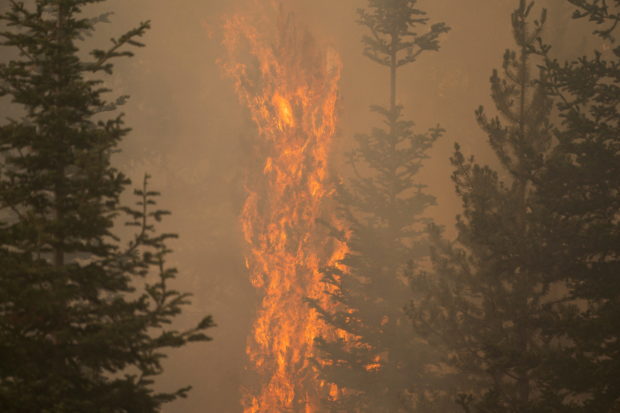Lightning found to have ignited Oregon’s mammoth Bootleg fire

The Bootleg Fire burns through vegetation near Paisley, Oregon, U.S., July 20, 2021. REUTERS
A destructive Oregon wildfire that ranks as the largest among dozens raging across the drought-parched Western United States in recent weeks was ignited by lightning but smoldered for days before it was detected, forest officials said on Wednesday.
The origin of the so-called Bootleg fire, which was first reported July 6 in the Fremont-Winema National Forest some 250 miles south of Portland, came to light as ground crews made increasing headway in curtailing the blaze.
Strike teams were taking advantage of calmer winds, cooler temperatures and slightly higher humidity over the past two days to extend and bolster containment lines around the fire’s periphery, incident commanders reported in their latest summary.
Although the blaze continued to expand, its growth was stunted as flames advanced into an old fire-scarred area with less vegetation available to burn, officials said.
As of Wednesday, the Bootleg had charred 395,463 acres (160,038 hectares) of tinder-dry brush and timber – an area well over half as big as Rhode Island. At that size, the fire was just a few hundred acres away from becoming Oregon’s third largest on record since 1900.
Article continues after this advertisementIt also has blackened far more acreage than any one of about 80 major active wildfires currently reported in 13 Western states this week. Those fires, along with the Bootleg, have collectively scorched more than 1.3 million acres (526,000 hectares) in an unusually heavy start to the Western fire season that experts say is symptomatic of climate change.
Article continues after this advertisementAlthough hot, dry, windy weather has played a key role in stoking this summer’s spate of wildfires, many were ignited by lightning strikes.
The cause of the Bootleg fire had been listed as under investigation until Wednesday, when officials revealed its ironically humble beginnings.
Forest Service investigators determined it was sparked by a lightning strike from a storm that was previously known to have ignited a smaller, nearby fire that was extinguished on June 30, Oregon Forestry Department spokesman Marcus Kauffman told Reuters.
Unknown to authorities at the time, an invisible “holdover” fire that would ultimately grow into the Bootleg smoldered unnoticed – apparently concealed beneath mounds of pine needles, cones and duff on the forest floor – before it was detected and reported on July 6, Kauffman said.
Although no fatalities or serious injuries have been reported, the Bootleg has destroyed at least 67 homes and more than 100 outbuildings and other structures.
Some 3,400 dwellings remained listed as threatened, many under evacuation orders or notices for residents to be ready to flee at a moment’s notice.
An army of some 2,200 personnel, backed by water-dropping helicopters and airplane tankers, has managed to carve containment lines around nearly a third of the fire’s still-growing perimeter, officials said on Wednesday.
The Bootleg fire is so large that it has at times generated its own weather – towering pyrocumulus clouds of condensed moisture sucked up through the fire’s smoke column from burned vegetation and the surrounding air. These clouds can spawn lightning storms and high winds capable igniting new fires and spreading the flames.